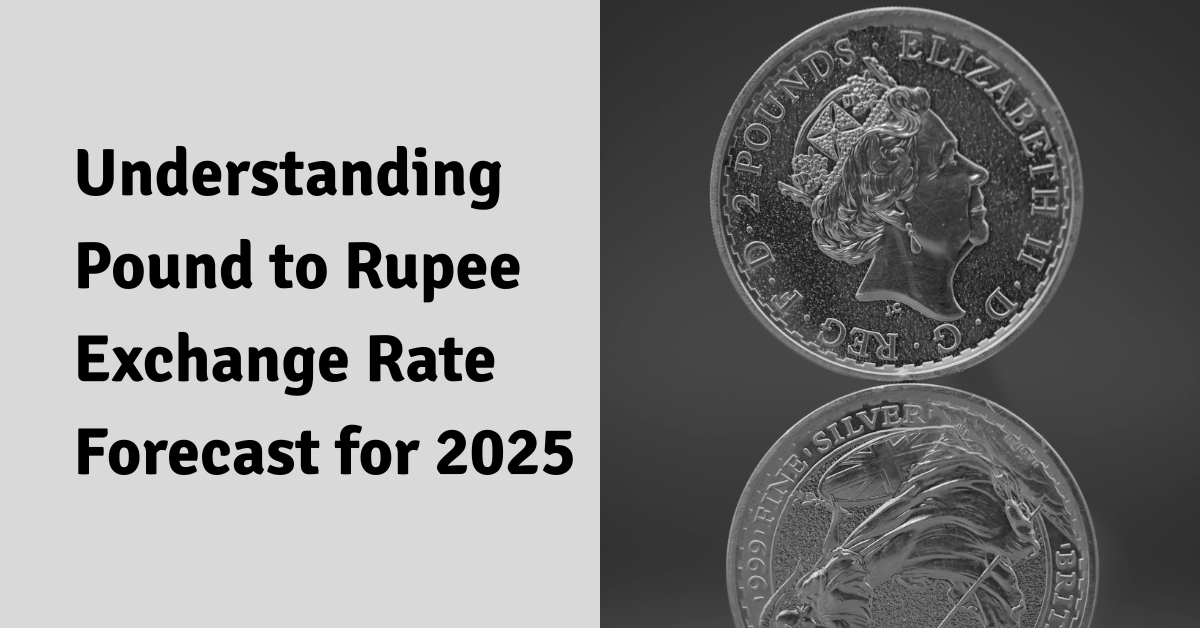Understanding Pound to Rupee Exchange Rate Forecast for 2025

The British Pound’s performance against the Indian Rupee significantly impacts millions of people from students pursuing education in the UK to businesses engaged in Indo-British trade, and investors managing cross-border portfolios. Understanding the GBP to INR trajectory is essential for making informed financial decisions in an increasingly interconnected global economy.
This comprehensive analysis examines the GBP to INR exchange rate forecast for 2025, providing detailed insights into market dynamics, expert predictions, and strategic implications for various stakeholders.
Understanding GBP to INR Exchange Rate Fundamentals
The British Pound to Indian Rupee exchange rate operates within a sophisticated framework influenced by monetary policies, economic performance, and global market conditions. Unlike many emerging market currencies, the GBP/INR pair reflects the interaction between a major reserve currency and one of the world’s fastest-growing economies.
Monetary Policy Landscape
Bank of England’s Stance The Bank of England (BoE) maintains a hawkish monetary policy stance, with interest rates held at 4.25% throughout 2025. This elevated rate environment, compared to historical norms, provides fundamental support for the Pound. Market expectations suggest potential rate cuts to 4% in 2026, but only if inflationary pressures subside and economic conditions stabilize.
Reserve Bank of India’s Approach The RBI’s policy framework focuses on balancing growth support with inflation control. Interest rate differentials between the UK and India create capital flow dynamics that significantly influence the GBP/INR exchange rate. The RBI’s approach to managing external sector stability while supporting domestic growth creates a complex policy environment.
Policy Divergence Impact: The interest rate differential between the UK and India continues to favor the Pound, with UK rates substantially higher than Indian rates. This differential attracts capital flows toward UK assets, providing structural support for GBP strength against the INR.
Economic Performance Indicators
UK Economic Dynamics The UK economy faces mixed signals in 2025, with growth concerns balanced against resilient service sector performance. Brexit-related adjustments continue to influence trade patterns, while energy security improvements support economic stability. The UK’s focus on financial services and technology sectors provides some insulation from global manufacturing slowdowns.
Indian Economic Trajectory India’s economy demonstrates robust growth momentum, driven by domestic consumption, digital transformation, and infrastructure development. However, the current account deficit and energy import dependence create vulnerabilities that can pressure the Rupee during periods of global uncertainty.
Relative Performance Assessment The UK’s mature economy offers stability but limited growth potential, while India’s dynamic economy provides growth but with higher volatility. This fundamental difference creates ongoing tension in the GBP/INR exchange rate, with economic cycles in both countries influencing currency movements.
Global Market Influences
Risk Sentiment and Safe Haven Demand The Pound’s status as a major currency provides some safe haven characteristics, particularly during regional uncertainties. Global risk-off periods typically favor the GBP over the INR, as investors seek stability in developed market currencies.
Commodity Price Impact Oil and commodity prices significantly affect India’s current account balance and inflation trajectory. Higher energy costs typically pressure the Rupee, while favorable commodity price environments can support INR strength against the Pound.
Trade and Investment Flows UK-India trade relationships continue evolving, with services trade, technology cooperation, and investment flows creating ongoing currency demand patterns. The UK’s position as a financial center for Indian companies’ international operations maintains structural GBP demand.
“Monitor live INR–GBP currency movements with Exchange Rate Converter — essential for importers, exporters, and anyone tracking the global market.”
Current Market Analysis and 2025 Outlook
Present Market Conditions
As of July 2025, the GBP/INR exchange rate trades around ₹116.75-117.00, representing a significant recovery from earlier 2025 lows. The Pound has demonstrated resilience, climbing from a 2025 low of ₹105.27 to current levels, marking a substantial appreciation of over 10%.
Key Performance Metrics:
- Current Rate: ₹116.76 (July 2025)
- 2025 High: ₹116.68 (as recorded)
- 2025 Low: ₹105.27
- 2025 Average: ₹111.20
- 30-Day Average: ₹116.76
- 90-Day Performance: +5.38% gain
Expert Forecasts and Market Consensus
Leading Analyst Predictions:
CoinCodex provides the most comprehensive outlook, projecting the GBP/INR to trade between ₹117.78 and ₹134.49 throughout 2025, with an average expected rate of ₹125.07. This forecast suggests continued Pound strength driven by BoE policy support and relative economic stability.
Traders Union offers a more conservative year-end target of ₹121.12 for 2025, indicating modest but sustained appreciation from current levels. Their technical analysis shows “Buy” signals across multiple timeframes, supporting the bullish outlook.
BookMyForex’s near-term projections indicate rates of ₹116.90 for October 2025 and ₹117.51 for November 2025, suggesting consolidation around current levels with gradual upward movement.
WalletInvestor’s analysis points to potential targets of ₹119.43 with upside scenarios reaching ₹116.67 and downside risks to ₹115.21 over the next 14 days, indicating short-term volatility within an upward trend.
Market Sentiment Analysis: Technical indicators across daily and weekly timeframes show “Buy” recommendations, suggesting continued bullish momentum. The GBP/INR pair trades above key moving averages, indicating technical strength supporting fundamental factors.
Historical Performance Context
2025 Trajectory Analysis: The GBP/INR pair has demonstrated remarkable resilience in 2025, recovering from early-year weakness to establish a strong upward trend. This performance reflects the UK’s economic adaptation and the Pound’s relative strength in global currency markets.
Comparative Performance: Compared to other major currencies, the Pound’s performance against the Rupee has been notably strong, outperforming many developed market currencies. This strength reflects both UK-specific factors and India’s economic challenges in managing external sector pressures.
Volatility Patterns: The pair has exhibited typical emerging market currency volatility, with periods of rapid appreciation followed by consolidation phases. This pattern suggests continued volatility but within an overall upward trend framework.
You may like to read: Why is the British Pound Getting Stronger Against the Indian Rupee in 2025?
Scenario Analysis for Remainder of 2025
Optimistic Scenario (Probability: 35%)
Target Range: ₹125-135 by December 2025
Key Drivers:
- Sustained UK economic resilience with service sector strength
- Continued BoE hawkish stance supporting GBP
- Indian current account pressures from higher oil prices
- Global risk-off sentiment favoring developed market currencies
- Successful UK trade diversification post-Brexit
Implications:
- Significant cost increases for Indian students and professionals in the UK
- Favorable environment for UK exporters to India
- Potential headwinds for Indian IT services companies serving UK clients
- Increased attractiveness of UK assets for Indian investors
Base Case Scenario (Probability: 45%)
Target Range: ₹118-125 by December 2025
Key Drivers:
- Moderate UK economic growth with controlled inflation
- Gradual BoE policy normalization without aggressive cuts
- Stable Indian economic performance with managed external sector
- Balanced global risk sentiment
- Steady UK-India trade relationship development
Implications:
- Manageable impact on most cross-border transactions
- Continued gradual appreciation trend supporting UK interests
- Balanced environment for bilateral trade and investment
- Moderate pressure on Indian companies with UK operations
Pessimistic Scenario (Probability: 20%)
Target Range: ₹112-118 by December 2025
Key Drivers:
- UK economic slowdown with potential recession risks
- Aggressive BoE rate cuts to support growth
- Strong Indian economic performance with current account improvement
- Global risk-on sentiment favoring emerging markets
- Trade tensions affecting UK economic prospects
Implications:
- Relief for Indian students and businesses with UK exposure
- Challenging environment for UK exporters to India
- Potential opportunities for Indian companies to expand UK operations
- Reduced attractiveness of UK assets for Indian investors
Strategic Implications and Recommendations for NRIs
Portfolio Diversification: Investors should consider currency exposure in their portfolio allocation decisions. The GBP/INR trend suggests Indian investors may benefit from UK asset exposure, while UK investors might find Indian assets more affordable.
Travel and Lifestyle: UK travelers to India benefit from Pound’s strength, while Indian travelers to the UK face higher costs. Both should consider timing and currency conversion strategies.
Property Investment: The currency trend affects cross-border property investments, with UK property becoming more expensive for Indian buyers and Indian property more affordable for UK investors.
Conclusion
The GBP to INR exchange rate forecast for 2025 indicates continued Pound strength, with most analysts expecting the pair to trade between ₹118-125 for the remainder of the year. This outlook reflects the UK’s monetary policy stance, relative economic stability, and India’s external sector challenges.
The base case scenario suggests gradual appreciation driven by interest rate differentials, relative economic performance, and global risk sentiment. However, significant volatility remains likely, requiring active risk management and flexible strategies.
Success in navigating GBP/INR fluctuations requires understanding both countries’ economic fundamentals, monitoring key policy developments, and implementing appropriate hedging strategies. Whether managing educational expenses, business operations, or investment portfolios, stakeholders must balance opportunity with risk in an evolving currency environment.
The strengthening trend in the GBP to INR exchange rate brings both potential gains and risks. Currency movements like these affect not only traders and businesses but also individuals with financial connections between the UK and India. This includes parents funding overseas education, professionals sending money home, or investors diversifying across borders. In such situations, having the support of a trusted financial advisor for NRIs can make a big difference. With the right guidance, it’s easier to plan around volatility, manage exposure, and make confident financial decisions in a constantly changing environment.
Frequently Asked Questions
1. What is the most likely GBP to INR exchange rate by December 2025?
Ans – Based on current analysis, the most probable range is ₹118-125, with consensus expectations around ₹121-122. This represents continued gradual appreciation from current levels, driven by interest rate differentials and relative economic performance.
2. How does the Bank of England’s policy affect GBP/INR rates?
Ans – The BoE’s hawkish stance, maintaining rates at 4.25%, provides fundamental support for the Pound. Any policy changes, particularly rate cuts, would likely weaken the GBP against the INR. Market expectations for potential easing in 2026 create forward-looking pressure.
3. What impact does India’s current account deficit have on the exchange rate?
Ans – India’s current account deficit creates structural demand for foreign currency, typically pressuring the Rupee. Higher oil prices or increased import demand can worsen this deficit, potentially strengthening the GBP/INR rate.
4. How can students manage currency risk for UK education expenses?
Ans – Students should consider forward contracts to lock in rates for future payments, systematic currency conversion to average out volatility, and education loan products with built-in currency hedging. Early planning and regular monitoring are essential.
5. What hedging strategies work best for businesses with GBP/INR exposure?
Ans – Businesses should use forward contracts for predictable cash flows, options for contingent exposures, and natural hedging through operational adjustments. The choice depends on exposure type, risk tolerance, and cost considerations.
6. How do global events affect the GBP/INR exchange rate?
Ans – Global risk-off events typically favor the GBP as a relatively safe developed market currency. Conversely, risk-on sentiment and strong global growth can support the INR. Oil price movements particularly affect India’s external sector and currency strength.
7. Is now a good time to convert INR to GBP for UK investments?
Ans – Given the upward trend, gradual conversion strategies may be preferable to timing the market. The current trajectory suggests potentially higher costs later, but systematic approaches often outperform attempts at perfect timing.
8. How do Brexit effects continue to influence GBP/INR rates?
Ans – Brexit adjustments continue affecting UK trade patterns and economic structure. While major disruptions have passed, ongoing adaptations in trade relationships and economic policies maintain some influence on currency movements.
9. What role does the UK’s service sector play in currency strength?
Ans – The UK’s strong service sector, particularly financial services, provides economic resilience and currency support. Service exports to India and other markets create ongoing GBP demand, supporting the currency’s strength.
10. How should investors approach GBP/INR exposure in their portfolios?
Ans – Investors should consider currency exposure as part of overall portfolio strategy, using diversification across currencies and time periods. Currency-hedged products, systematic rebalancing, and regular monitoring help manage exposure effectively.
11. What are the key technical indicators to watch for GBP/INR?
Ans – Key indicators include moving average crossovers, relative strength index (RSI) levels, support and resistance zones, and volume patterns. Current technical analysis shows “Buy” signals across multiple timeframes, supporting the bullish outlook.
12. How do monsoon patterns affect the GBP/INR exchange rate?
Ans – Monsoon patterns significantly impact Indian agricultural output, inflation, and rural demand. Poor monsoons can pressure the Rupee through increased food inflation and reduced agricultural exports, potentially strengthening the GBP/INR rate.
Disclaimer: The information provided here is for educational and informational purposes only and should not be construed as financial, legal, or tax advice. Consult with a qualified professional before making any investment decisions. We do not accept any liability for errors or omissions in this information nor any direct, indirect, or consequential losses arising from its use.



